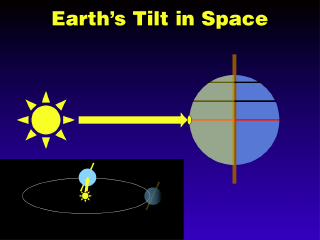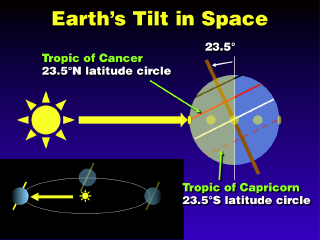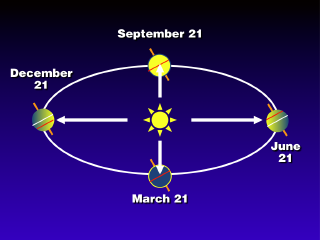


 |
 |
 |
The plane that contains the orbit of the Earth around the sun is the Celestial Plane. A line perpendicular to this plane is "vertical"; the Earth's rotation axis is tilted 23.5 degrees from this vertical.
As the Earth orbits around the sun, the axial tilt maintains its orientation in space (see inset) so the sun shines straight down on a different latitude at different times of the year (depicted by the row of yellow dots on the Earth).
Due to the 23.5 degree tilt, the spot on Earth where the sun is directly overhead varies in latitude between 23.5 N and 23.5 S. The extremes are the Tropics of Cancer and Capricorn, after the names of the constellations in which the sun is located at the times of the year where it is shining directly down on a latitude most north or most south of the Equator. If the Earth was tilted at a larger angle, the "tropics" would be higher latitudes corresponding to the new tilt angle, according to the orbital geometry. Consequently, if the Earth was not tilted (tilt angle 0 degrees), the sun would shine over the Equator all year round.
 |
On March 20 and September 22, the sun is shining directly over the Equator. The Earth is still tilted 23.5 degrees. If the Earth was tilted more or less than 23.5 degrees, the sun would still be shining directly over the Equator because the tilt plane is perpendicular to the sunlight beams. On June 21, the sun is shining on a latitude circle most north of the Equator (Tropic of Cancer). This causes the Sun to appear relatively high in the sky at noon (resulting in a high noontime solar altitude) over northern latitudes. Meanwhile, in the Southern Hemisphere at this time, the average noontime solar altitude would be at its smallest value. On December 21, the sun is shining on a latitude circle most south of the Equator (Tropic of Capricorn). The solar altitude for the sourthern latitudes would be pretty large at this time, while they would be at their smallest values of the year over the northern latitudes. Note that these dates are approximate (and may not exactly correspond to the dates noted in the textbook; from year to year, the dates the sun is overhead a particular latitude may vary by plus or minus a day or two. |